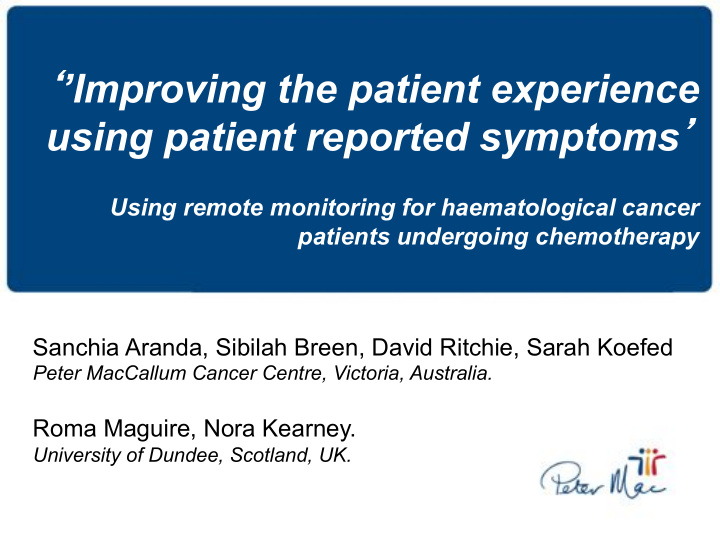



� ’Improving the patient experience using patient reported symptoms � Using remote monitoring for haematological cancer patients undergoing chemotherapy Sanchia Aranda, Sibilah Breen, David Ritchie, Sarah Koefed Peter MacCallum Cancer Centre, Victoria, Australia. Roma Maguire, Nora Kearney. University of Dundee, Scotland, UK.
Background • Real-time remote monitoring systems are a cost-effective mechanism for improved patient care/outcomes in chronic disease • Early studies of real time remote monitoring systems in patients receiving cancer treatment show: – Improved symptom reporting/control and psychological status – Decreased hospital admissions and BDOC • A focus on high-risk/clinically challenging groups is warranted – haematological cancers – high toxicity chemotherapy protocols – Most likely to benefit clinically
Previous Work • Self Care Information Review • ChemoEd Trial
Limitations • Reliance on retrospective recall • No ability to tailor information to patient experience • Absence of real time connectivity at the time patients experience of side effects and symptoms • Salience of chemotherapy preparation information before side effects and symptoms occur
2a. Mobile phone provides tailored self- 1. Patient Completes Symptom Local care advice in response to reported Questionnaire symptoms • Twice daily/feels unwell • Key symptoms + temperature Advanced 3. Patient can also view symptom graphs and additional self care Symptom information tailored to side effects Management System (ASyMS) 2b. Data sent in ‘real-time’ via GPRS to secure server 5. Clinicians contact patient to provide • encrypted advice where appropriate • no identifying information 3. Problematic symptoms generate alerts via pager or emergency SMS text to dedicated pager/phone 4. Nurses view symptom data on a • amber/red secure website • individual/combination concerns
Screen Shots From Patient Mobile Phone Handset
Screen Shots From Nursing Website
Pilot testing with Smart Phone • Aimed to: – Assess end-user acceptability/feasibility of system – Assess frequency and reasons for system alerts – Assess rates of user compliance – Assess changes required for system refinement
Results (patients) • System used by patients for total of 365 days • Thirty two medical alerts generated (red -11; amber – 21) – Nausea – Mucositis – Temp >38 degrees • 12 missing alerts generated (system not used >24 hours) – 6 alerts from 1 patient • Compliance with daily use – 97%
1. acceptability/feasibility • Easy to use & fits with routine • One patient lacked confidence to fully utilize all functionality “Its so easy to use. I think small children could be taught to use It wasn’t a burden at all after you that..” P4 became “I didn’t want to accustomed to the play outside the routine of doing it area [symptom each day … I found I questionnaires] adapted automatically to just in case I upset doing it like the phone or brushing my teeth anything” P1
2. positive impacts on care • Security, reassurance & shared management • Understanding and planning • Empowered and pro-active • Communication & early intervention • Benefits of Real time reporting • Future benefits : predictive modelling
3. Appropriateness of content • Symptom Questionnaire “[The] questions were pretty thorough so I am not sure you can really add that much … it covered all bases.’ P • Self Care Information “It had everything in one spot rather than having to go somewhere and pick up a folder … summarized it nicely … ” P9
4. Limitations • Mobile coverage • Manipulating answers and guilt • More useful for symptomatic patients • Application on own phone or the internet • More useful for symptomatic patients
Nursing Views Acceptability/Feasability • Easy to use/easier than expected • Fit with routine and current roles Effect on Process of Care • Decrease inappropriate calls/controlling workload • Consistency of assessment and advice • Repeated alerting and repeated contacts appropriate • Potential to allow patients to leave hospital sooner
Conclusions • Highly acceptable/feasible to patients and nurses • Numerous benefits for patients/cancer nurses • High compliance • Need to adapt symptoms monitored; some wording; reformat website and address performance issues • Need to ensure that patients are supported to use system effectively: – Use handset functionality – Keep reporting accurately and not feel guilty about taking up nurses time (normalise follow up)
Next Steps • System has been re- programmed into an Android app • Phase 3 RCT in progress incorporating structured nursing support at set intervals in addition to responding to alerts
Acknowledgments • The Victorian Cancer Agency for funding the development of the prototype system and the current phase 2 trial • Hematology patients who gave their valuable time to participate in this project • The hard working nurses in the Chemotherapy Day Unit and the Patient Service Managers who have given, and continue to provide, amazing support for new research initiatives • The authors have no conflicts of interest to declare
Recommend
More recommend